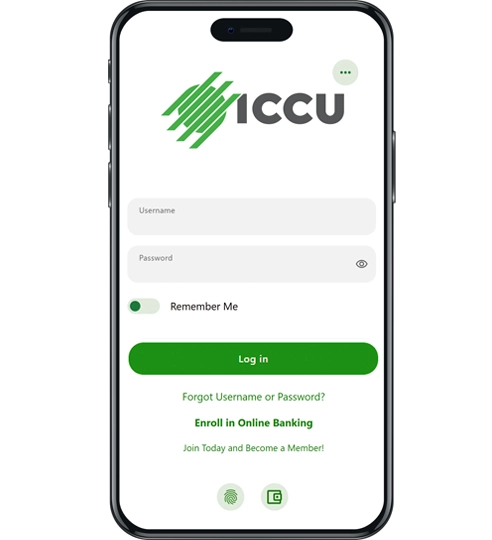Bank On The Go
At ICCU, we believe banking should be easy. We provide convenient access to the right tools so you can achieve financial success no matter where you are.
Free Mobile & Online Banking
You have all the tools you need to manage your accounts through the ICCU mobile app or on ICCU.com, anywhere, anytime. Check balances, transfer money, pay bills, set up alerts, and so much more.
VideoChat
Bank face-to-face from anywhere in the world with a live service agent through ICCU’s VideoChat. Not only is it convenient, it’s secure and easy to use for account questions, opening a new account, applying for a loan, and much more!
Free Zelle® Money Transfers
Zelle is a fast, safe and easy way to send money to people you trust, right from the ICCU mobile app – no matter where they bank.
My Credit
My Credit is a free service powered by SavvyMoney®. Stay on top of your credit by checking your score, viewing your credit report, and getting up-to-date credit monitoring notifications.
CardControl
Stay in control of all your ICCU Visa cards with CardControl. Turn your card(s) on and off, set control and alert preferences, set spending limits and merchant categories, and more.
Make a Payment
Are you ready to make a payment at ICCU? Get ready to experience the ultimate convenience and speed with our range of payment options! Whether you’re paying bills, transferring money, or making a loan payment, we’ve got you covered.
Banking Right at Your Fingertips
With more options available to you than ever before, you can skip the lines, and enjoy all these services from the comfort of your home. Even while sipping on your favorite coffee! Just another way we are looking after your daily balance.
Mobile & Online Banking Tools:
Convenient Services:

Additional Resources

Our services don’t stop there. Anytime, anywhere, pull out your phone or jump online to view all the perks that ICCU has to offer. Check out a few more services below and enjoy a little more financial freedom.
